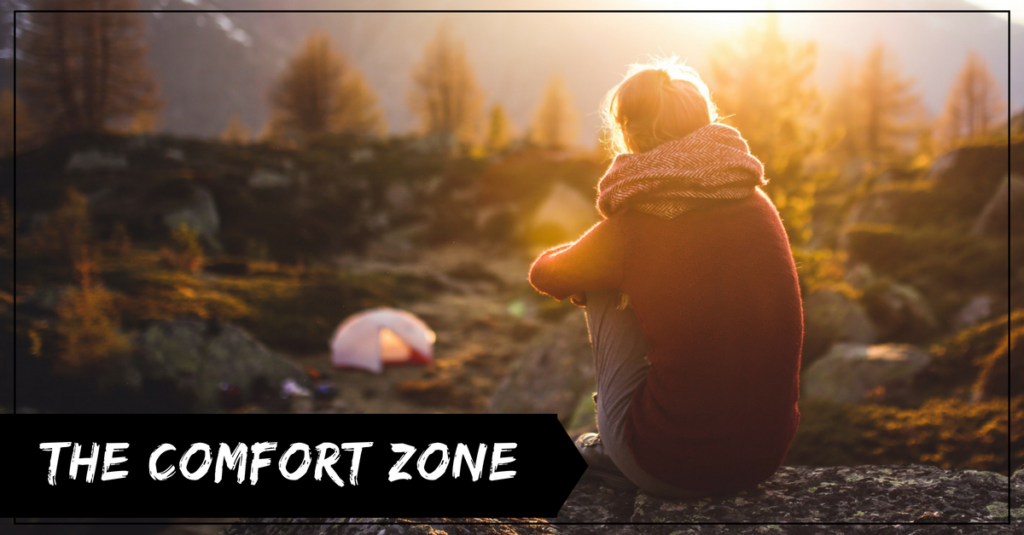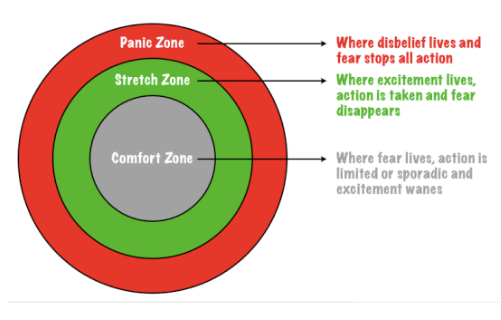What’s your comfort zone?

In this blog, we are going to answer the question, what is the comfort zone. .Brené Brown a research professor at the University of Houston explains the comfort zone as “Where our uncertainty, scarcity and vulnerability are minimized — where we believe we’ll have access to enough love, food, talent, time, admiration. Where we feel we have some control.”
By understanding the comfort zone, we can use it to our advantage. We learn the process of controlling our anxiety and fear, our confidence grows and the process is inspiring as we see the compounding effect of our positive, courageous decisions.
As an extreme sports enthusiast, professional fighter and big fan of adventure in general, I believe stepping out of the comfort zone is vital for growth. As a mentor, performance coach and martial arts Instructor I believe we can drastically improve any individual’s mindset and quality of life by helping them take small steps out of their own comfort zone.
Whenever we step out of our comfort zone a stress response is generated which results in an increase of adrenaline which enhances our concentration and focus and puts us in a state to prepare for the activity we are about to put ourselves through.
Depending on the comfort zone of the individual (which can be modified and moulded around your actions, training and mindset); standing up to deliver a speech in front of a few hundred people can create more of a “stressful response” than jumping from a 1,500ft cliff with a parachute. Not all fear is created equally and its true to say that in many cases fear of social rejection can be stronger than fear of injury, more on this later, for now it’s important we understand that the comfort zone varies massively from individual to individual and the training should reflect that.
Robert Yerkes, an American psychologist best known for his work in intelligence testing and in the field of comparative psychology, (1907) reported:
“Anxiety improves performance until a certain optimum level of arousal has been reached. Beyond that point, performance deteriorates as higher levels of anxiety are attained. Beyond the optimum performance zone, lies the “danger zone” in which performance declines rapidly under the influence of greater anxiety.”
With this in mind it’s important we understand how to reach this optimal zone without remaining in our comfort zone and without reaching the danger zone. Certainly there’s a fine line between these ‘zones’ and the line is always moving as we grow and develop.
When we are forced to make a decision under pressure, while we are in a state of stress, out of our comfort zone, we typically make poor decisions, or we focus on fewer alternatives, instead we use familiar strategies that we have used before, even if they are not particularly helpful.
Stepping out of our comfort zone regularly, does a whole host of fantastic things to develop us:
– It drastically improves our confidence, which is a vital aspect of our growth and creates huge amounts of opportunity in our lives.
– It teaches us to make decisions in stressful situations, which develops our leadership capability.
– It teaches us to control our minds and remain calm in stressful situations.
– By expanding our comfort zone we seek out more challenges and become more goal oriented, as our comfort zone expands (as we leave it) we become more driven.
– It can provide us with adventure and enrich our lives, (more later on the power of “adventure”).
Looking at the diagram below, imagine yourself in the small circle right now, the “comfort zone”, sitting down (or standing?) reading this book. Imagine yourself now in front of a large audience of 2000 people and you are reading this paragraph out loud, you are being broadcasted on national TV, live, and there is no room for error. Depending on your comfort zone, at this stage you are likely to be leaving your comfort zone. As we gradually push out of our comfort zone and into the high performance zone our stress levels increase and our “fight or flight” reaction is triggered, we either quickly run back into the comfort zone “flight” or we “fight” through the immediate stress, make bold decisions and remain in the high or “optimal” performance zone.
The next time we go back into the optimal performance zone it is larger as we are able to deal with the stress more efficiently. What as previously uncomfortable has become familiar and we have expanded our comfort zone. So the next time you are on live TV it shouldn’t be quite so terrifying.

As part of the Warrior Method we teach our students about public speaking due to its practical application in their adult lives and its effect on their mindset, confidence, leadership and it’s power to inspire the other students.
So, let’s put this into perspective in the form of a public speaking scenario within the context of one of our martial arts classes, to give an insight into how the comfort zone can be used as a process for developing Black Belt confidence.
A child who is absolutely terrified of speaking in front of a group of their peers is encouraged to stand up next to the instructor in front of all of the other students and shout out the numbers 1 to 5 while the group of students perform a front kick off the back leg. This simple exercise brings the student into a stressful place, they are now in their “optimal performance zone” as they are out of their comfort zone but their is no “danger” to themselves. The task of counting 1 to 5 is simple enough so that the child does not need to rely on more intricate decision making while in a stressful situation. Once completed, a huge round of applause is given, the child bows and joins back in with their peers, task completed.
The next time the student is asked to go out, they may be asked to go up on their own and shout the numbers out. Followed with a bow and a big round of applause to reinforce the positive experience and receive social recognition.
The following time they are asked they may be asked to describe the kick or use an alternative kick, again followed by social recognition in the form of an applaud.
The next time after this they may be asked to deliver a complicated combination of 3 or 4 techniques, describe what they are teaching and correct anyone in the group who makes a mistake. 1 to 5 as per normal and concluded with applause, perhaps rewarded with a leadership “stripe” on their belt for their progress to solidify the pride in their leadership.
After this as part of their grading they may be asked to deliver a the same mini-lesson in front of 20 parents and 20 of their peers in exam conditions as part of their grading. Concluded with applause from the whole room and perhaps an award for excellent leadership.
Now looking back at where we have come with this particular child we can see a huge amount of growth from taking mini steps out of their comfort zone and into the optimal performance zone.
They key is to optimize the optimal performance zone and I believe strong mentoring, excellent peer group support and positive reinforcement achieves this, along with regular visits to the optimal performance zone so that it doesn’t become a stranger and in some way, we feel comfortable with feeling uncomfortable.
You can find more about our clubs and classes by visiting https://www.warrioracademy.co.uk
In our next blog we will be going deep on why Martial Arts is such an excellent tool for developing Black Belt Confidence in our children…

